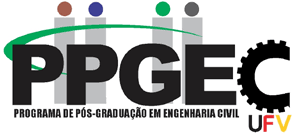Laboratory of Soil Mechanics (LMS)
The Laboratory of Soil Mechanics incorporates laboratory and field equipment used in the research lines of the Area of Concentration in Geotechnics. Apart from electronic scales with precision ranging from 0.001 to 0.1 g, equipment for soil characterization, compaction tests (molds), glassware and reagents, the laboratory has presses, chambers and triaxial panels for samples of varying sizes; a Bishop-Wesley chamber; a cubic triaxial equipment for testing saturated and unsaturated soils; a servo-controlled cyclic triaxial equipment; a cyclic triaxial equipment adapted from a static system, with instrumentation internal to the chamber; a quasi-static penetrometer; penetrometric cone penetration rod; data acquisition system; a set of optical microscope and digital photography system, for use in determining the morphology of sands; incremental compaction presses; a CRD (“Constant Rate of Deformation”) type oedometric cell, for mud consolidation testing; an HCT (“Hydraulic Consolidation Test”) type oedometric cell, for sludge consolidation testing; pressure chambers, to determine water retention curves in soils; permeability panels, for constant and variable load tests; acrylic permeameters with outlets at the top, middle and base of the sample; a system for column permeability and percolation tests; large sets for carrying out rock alterability tests; cells for running column assays simultaneously on four samples per cell (contaminant transport); cells for performing diffusion assays (Barone type); desktop microprocessor digital centrifuge; an orbital shaking table; sets for carrying out the Inderbitzen test (soil erodibility); a set for classifying soils according to the MCT methodology; CBR testing presses with overload sets; a 50 kN Marshall press; Mini-CBR compaction equipment; HARVARD compaction equipment; funnel and sand sets; set for carrying out the sand equivalent test; point compression test equipment (Point Load Test); diverse instrumentation for data capture, including volume variation meters, internal load transducers for triaxial chambers, external load transducers, transducers for pore pressure measurement, inductive and resistive displacement meters, differential pressure transducers, mechanical extensometers, stabilized sources , multimeters and switch boxes, etc.; press for carrying out uniaxial compression tests on rocks, without servo control; a digital Schmidt sclerometer; with steel support for testing; several desiccators for saturating samples, a vacuum pump; equipment for determining wave propagation speed in rock and concrete (PUNDIT); equipment for sawing rock and concrete specimens with two diamond saws; a drill for extracting rock cores with various cups and diamond crowns; a magnifying glass for mineral identification; two Soxhlet extractor equipment; a CERCHAR abrasive equipment (unique in Minas Gerais); a Compression – Traction Conversion apparatus; benchtop pH meters, digital; complete lathe used to carry out repairs and construction of laboratory, field and instrumentation equipment. Field equipment includes an electrical resistivity meter; Benkelman beam; complete set for carrying out the dilatometric test (Marchetti dilatometer); piezocone (penetrometric cone); complete set for carrying out the pressure test; complete SPT sounding set; complete set of mechanical auger; total pressure monitoring set; complete inclinometric set; pHmeter/conductivity meter; telescopic rod for water sampling; complete equipment for carrying out Point Load tests in situ; pump set and electrical panel for carrying out water level lowering and recovery tests; and complete set for carrying out load tests in the field.
In terms of programs, the Geotechnical Laboratory has all Rocscience software (CPillar, Dips, Examine 3D, Rocdata, RocFall, RocPlane, Rocsupport, RocTopple, RS2, RS3, RSPile, Settle3D, Slide, Slide3D, Swedge and Unwedge) , for a total of 25 licenses, updated annually. It also has deterministic and probabilistic stability analysis software from PLAXIS, provided by the company. The work carried out in the Geotechnics Laboratory has a direct connection with the Geotechnics area, but with a strong interface with the Sanitary and Environmental and Construction Materials areas, on the topics of environmental monitoring of surface and underground waters, waste management, environmental studies of projects, development and evaluation of materials for paving and soil reinforcement and the use of rocks as construction materials. In relation to other departments, institutions and graduate programs, the Geotechnics Laboratory has had intense interaction with the Soil and Plant Nutrition departments and with Agricultural and Environmental Engineering, with which it is currently developing several engineering projects. research and extension. The Soil and Rock Mechanics laboratories have had an intense and fruitful relationship with mining companies, involving carrying out tests, characterization, physics, chemistry and mineralogy of rocks and soils, triaxial, shear, compaction and permeability tests in soils; and simple, point compression, mineralogical analysis, wave propagation speed, abrasive traction of rocks and transitional materials in weathering profiles. The Geotechnics area has also had interaction with the Spatial Information and Cartographic area in studies involving silting of dam reservoirs.
